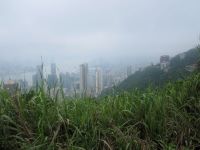
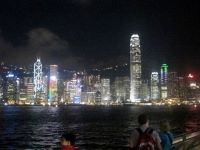 At over 1,300 feet, the “peak” in Hong Kong towers over the harbor and the island; it also provides the backdrop for one of the most engaging settings for any city in the world. Shanghai may have an equally impressive waterfront, but Hong Kong has mountains and water. When combined, the Chinese characters mean scenery, and that’s one word for Hong Kong. Walking along the promenade that fronts Victoria Harbor and the peak, at night with the buildings lit up, provides truly one of the most memorable sights on the trip. I remember the first time (in 1990) blurting out, “This is more western than New York,” and in some ways, it is.
At over 1,300 feet, the “peak” in Hong Kong towers over the harbor and the island; it also provides the backdrop for one of the most engaging settings for any city in the world. Shanghai may have an equally impressive waterfront, but Hong Kong has mountains and water. When combined, the Chinese characters mean scenery, and that’s one word for Hong Kong. Walking along the promenade that fronts Victoria Harbor and the peak, at night with the buildings lit up, provides truly one of the most memorable sights on the trip. I remember the first time (in 1990) blurting out, “This is more western than New York,” and in some ways, it is.
There’s an energy here that is palpable, fitting for a city that since its birth has been a commercial funnel between China and the West. The Qing dynasty, having spurned a Western emissary in 1792, saying the West had nothing China wanted, had limited trade to South China, the city of Canton. Unfortunately for the Chinese, the British did find something in India that the Chinese wanted to buy, and they bought it like they were addicted to drugs—it was opium. The drain of money from the country prompted the Chinese to try to ban the opium, and they burned it and threw the foreigners out of Canton in the late 1830s. Thus started the first Opium War, out of which came a treaty that ceded Hong Kong Island to the British—in perpetuity. A second opium war from 1858-1860 led to the acquisition of the Kowloon Peninsula, across from the island (and where we’re at), again in perpetuity. In 1898, in yet a third round of Sino-foreign troubles, the Chinese ceded the “New Territories,” but for only 99 years. The end of that treaty resulted in negotiations that in 1997 led to the handover of Hong Kong from the British to the Chinese. I still have a T-shirt, worn only that one night, that said, “Good-Bye Great Britain, June 30, 1997,” on one side, and “Hello, China, July 1, 1997.”
I know there were people who feared that China would rule Hong Kong with a heavy hand, but the PRC seems to have kept its word in the “Special Administrative Region.” There’s a lot of new public activity here—especially construction. A high-speed train is being built (I saw protests against it on the University of HK campus on partly environmental grounds) to Beijing and Shanghai that will bind the country more tightly to the mainland. And Beijing still hopes to reunite the “renegade province” of Taiwan to the mainland peacefully, which makes it imperative to make it seem possible for “one country” to have “two systems.” Hong Kong is still a major player in the trade with south China—the main port for products from Guangdong, the province north of here, to connect with the rest of the world. As was the case from 1841 on.
What’s there to do besides walk the city all night marveling at what there is to do 24/7 (I’ve actually done that)?
We did have a sightseeing tour that took us to the convention center (one of 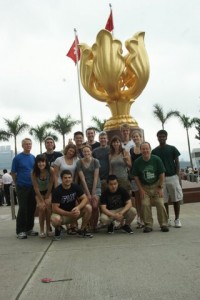 several projects the last governor of HK built to leave a less-than-full treasury; the wondrous airport with the longest three-layered bridge to it is another) where the handover ceremony took place, and with appropriate pomp and ceremony, Prince Charles and Governor Patten sailed into history in 1997; Aberdeen, once home to “boat people,” today a typhoon refuge for the tycoons and their boats as well as a smattering of fishing boats; Repulse Bay, the most expensive property on the island (with the best beach on the island on what they call here the “South China Sea,” that our guide in Hanoi said was the “Vietnam Sea”); the peak with its splendid views from 1385 feet looking down on the city/peninsula; the road up to it with houses famed in movies (“Love is a Many Splendored Thing,” “Suzy Wong,” and the eminently forgettable, “Soldier of Fortune,” in which Clark Gable becomes enamored with Mrs. Hoyt, played by Susan Hayward; lucky Mrs. Hoyt, and lucky Mr. Hoyt).
several projects the last governor of HK built to leave a less-than-full treasury; the wondrous airport with the longest three-layered bridge to it is another) where the handover ceremony took place, and with appropriate pomp and ceremony, Prince Charles and Governor Patten sailed into history in 1997; Aberdeen, once home to “boat people,” today a typhoon refuge for the tycoons and their boats as well as a smattering of fishing boats; Repulse Bay, the most expensive property on the island (with the best beach on the island on what they call here the “South China Sea,” that our guide in Hanoi said was the “Vietnam Sea”); the peak with its splendid views from 1385 feet looking down on the city/peninsula; the road up to it with houses famed in movies (“Love is a Many Splendored Thing,” “Suzy Wong,” and the eminently forgettable, “Soldier of Fortune,” in which Clark Gable becomes enamored with Mrs. Hoyt, played by Susan Hayward; lucky Mrs. Hoyt, and lucky Mr. Hoyt).
Then there’s eating. Dim sum is a south Chinese specialty, and we had lunch yesterday in a restaurant that had surprisingly few tourists, and not surprisingly outstanding food (tho, alas, the days of the carts coming by your table so you could see and select are numbered); a dinner last night accompanying one of my long time Hong Kong friends, a teacher at a 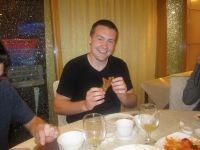 university here I met in Vietnam in 1995, who specializes in finding restaurants without English menus, and food none of us would venture to eat—I love the duck web feet we had, and I’ve never had it before.
university here I met in Vietnam in 1995, who specializes in finding restaurants without English menus, and food none of us would venture to eat—I love the duck web feet we had, and I’ve never had it before.
And (as is true in much of developed Asia) shopping in incredible blocks of shopping malls, stores, etc. Good tailors, reasonably priced. Cameras reasonably priced. Fashions. You name it. There’s an old Chinese saying (I made it up, I think), “You got money, no problems.” Several students will look more professional at work or school next year.
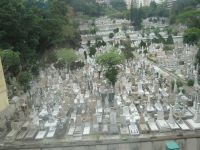
Finally, there’s culture for those interested. I went the other night to the Philharmonic, which debuted a work by a young Hong Kong composer (it had been played by the BBC before, but not in Asia), and one of my favorite pieces, Symphony Fantastique, Berlioz’ account of an opium-crazed jilted lover’s nightmares (as I learned from the notes), which at one time featured 4 timpanists! And the art museum had a great exhibit in the form of a “tourist guide” to the Pearl River delta in 1839-1860. One tidbit I learned was that the Chinese baker in Canton tried to poison the entire foreign community with arsenic, but gave so much that everyone vomited and everyone survived. I’ll watch what I eat!
Not bad for a city of “only” 7 million people, with the highest density in the world.